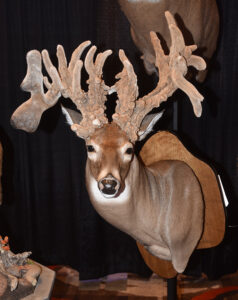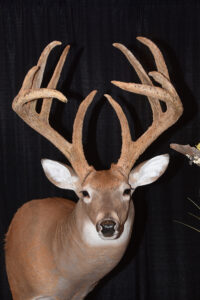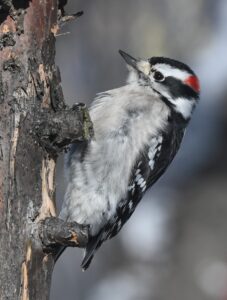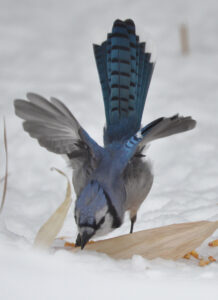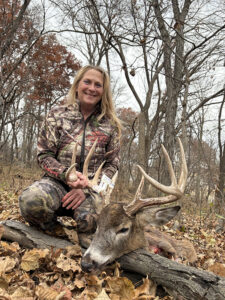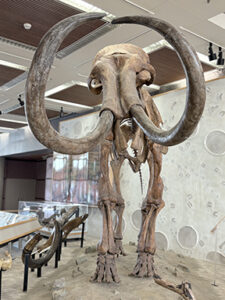Antlers are unique, no two the same
IOWA’s archery deer season is well underway. The bow season began Oct. 1 and runs through Dec. 5. Then archery season closes while Iowa gun deer seasons begin Dec. 6-10 and again from Dec. 13-21.
Later archery season recommences on Dec. 22 and continues through Jan. 10, 2026. As of midweek, across Iowa archers have reported taking 15,350 deer, both does or bucks. By the time archery season ends, that number will be about 30,000, if past yearly trend lines hold true for 2025.
Archery tackle is a very limited success weapon of choice. The bows may be long bow, recurve or compound designs. That choice is up to the archer.
The bow is handheld, hand drawn and hand released. The ability to aim and have a broadhead tipped arrow hit the vital area of deer’s chest is not easy.
Lots of practice is required at ranges or backyard targets or at summer archery course competitions. When Oct. 1 arrives each year, archers are thrilled to be back in the forest and field edges awaiting the passing of deer, hopefully along established trails.
There is no guarantee that the deer an archer would like to take will ever appear while the hunter is perched in their tree stand or ground blind. In the world of deer hunting, skills and advanced planning help.
Good tree stand locations help. Favorable weather helps. Good luck is always welcome and sometimes essential.
Bad luck is all too often the thing that happens. Given enough time, all the factors may align to have a deer within range. However, there is still no guarantee that the right deer in the right place at the right time may offer an ethical shot opportunity.
This author’s exploits of bow hunting began seriously in 1966 with his recurve Fred Bear bow on public land near Spearfish, S.D. I was in the right place at the right time to take a nice white-tailed deer buck from my perch in a pine tree.
His antlers were a mere small sized 3×3. I was not awaiting a big antlered deer, just any deer would do, especially for its meat to share with friends.
That was my first archery kill deer, and I was proud to have accomplished a bow hunting adventure. Any deer taken with a bow satisfies my definition of a “trophy.”
A word about the word trophy is needed. Lots of people who do not hunt think that is the only reason archers or gun hunters go deer hunting.
That is far from the truth. Taking a deer within the scope of pertinent regulations and other legal methods by bow or gun is what counts. If, and sometimes this is a big if, a large and very impressive antlered buck deer avails itself of a hunter, that is a good luck situation to have. Take the opportunity when presented because those circumstances will not happen every year.
To illustrate this point a bit more, bow hunting is a sport that requires persistence and patience. One will put in many years before all the factors may align.
It took me 39 years before I arrowed a nice antlered buck with sufficient growth, mass and point lengths to be eligible for entry into the Pope & Young Club record book. It took a few years more for my second large buck, and it took nine years between successes at one bow hunting site before those two additional entries qualified for the record book.
What does not go into record books are deeply etched memories of bow hunting adventures, each a valuable learning experience. Incidentally, doe deer meat tastes just as good, and way more doe deer meat have taken up space in my freezer than buck venison.
Now, 59 years later, I am still climbing trees to gain access to my tree stands. I also use ground blinds, sometimes natural hiding places I find, or by concealment inside a tent-like pop up device.
Inside, sitting on a portable chair, I await the possibility of a deer passing close by. Remember my previous comment — no guarantees.
I have seen that happen so many times I have lost count. A case in point happened again this year. While in a ground blind, I watched a nice antlered buck stroll past an unoccupied tree stand I sometimes use.
He was 85 yards away so no shot opportunity with my bow was possible. Why was I not in the tree stand? The answer was wind direction.
The wind was wrong that day for the tree stand and correct for the ground blind. That buck could have but did not take an equally doable route to go from his point A to point B. He was lucky, I was not. Next time, the cards may be in my favor.
With regard to antlers on any member of the deer family, called Cervidae by biologists and scientists, antlers are true bones that grow anew each year. At the end of the year those antlers will be shed, meaning drop off naturally, falling to the ground in all kinds of places where the moose, elk, mule deer, white-tailed deer or caribou live.
The calcium and other mineral content of antlers may become food for small rodents who gnaw upon those antlers, or a casual hiker may find a shed antler of last year or long ago nestled into the brush or landscape. If picked up, those antlers may become another memento to the finder, a trophy of accidental circumstances.
Horned animals like bison, wild sheep or goats, do not lose horns. The horn material is made of keratin, the same source material of fingernails. It is retained from year to year.
New growth takes place at its base to slowly make the horn a bit longer the following year. Deer have antlers, not horns.
Since the beginning of the history of mankind, people have been fascinated by both antlers and/or horns on animals. Stone age man made crude but interesting cave paintings of animals they encountered while using torch light and oxide pigments to make stick drawings of animals they hunted.
Hunting was necessary to survive. Cave wall drawings were evidence for future generations to look at. They left their mark for others to ponder over centuries or millennia later.
——–
Biologists and other scientists have wondered how deer see what they see. Obviously, deer can see well during day times and also exceedingly well at night.
There seemed to be nagging questions about abilities they possessed which humans do not have. Well, to paraphrase discoveries from the University of Georgia’s Deer Lab, deer do see what we see and things we cannot see.
Their eyesight is able to denote wavelengths of ultra violet light, at the rate of 20 times more sensitivity than people. Our human eye construction blocks most UV light below 400 nanometers. Deer bypass that range to their advantage.
Deer walking through the forest use their noses to discern all kinds of information about friend or foe. Buck deer like to scrape antlers against small tree saplings to rub off the velvet, and to leave scent calling cards for other deer, both buck and does.
University of Georgia researchers found that under UV spotlights, tree scrapes glow in the dark like highway markers to a deer’s vision. The University study of 2024 looked at a 840 acre area near Athens, Ga.
The team scoped out 109 fresh rubs and 37 scrapes during pre-rut conditions. Using UV flashlights at 365 to 395 nanometers to mimic crepuscular light, here is what they discovered. Rubs and scrapes don’t just carry scents, they shine through photo luminescence, where UV light triggers compounds to emit light wavelengths detected by deer vision. Background vegetation remained unaffected.
A current theory is this: natural compounds within the cambium layer of the tree, and perhaps in combination with forehead gland secretions from the deer, leave markers of emitted blue (450nm) and green (537nm), that together align perfectly with deer vision.
This is a fascinating new look by us humans and how nature has specific vision capabilities unknown to us. What deer see and how they see is not the same thing as human vision. Now, to add to these discoveries, deer urine also leaves visual clues that “shine” to other deer at the 365 nm wavelength, a source deer vision can detect.
This study of natural history together with all of its intricate biological factors helps scientists understand more about how things in nature work. I am also quite sure that no matter how much new investigations of science can uncover, we humans will never completely solve these intricacies and mysteries.
The wonders of nature never end.
——–
Garry Brandenburg is the retired director of the Marshall County Conservation Board. He is a graduate of Iowa State University with a BS degree in Fish & Wildlife Biology.
Contact him at:
P.O. Box 96
Albion, IA 50005
- PHOTOS BY GARRY BRANDENBURG White-tailed deer are the biggest wild game mammal in Iowa. They also are common in many other states or Canadian Provinces where they may coexist with other large members of the Cervidae family, namely moose, elk, mule deer and in some places caribou. However, white-tailed deer being a highly sought after animal during fall hunting seasons, they are accessible to just about any person in any state and in a wide variety of habitats. Antlers grown by male deer are renewed every spring and summer where these true bone growths finally reach a maximum for the year by fall. Each set of antlers is unique, displaying the typical curved main beam with several points growing off the top of those beams. And then there are what record keeping organizations of the Pope and Young Club (archery) or the Boone and Crockett Club (any method of take) call non-typical. Non-typical antler growth spans the spectrum from just enough odd points to an entire array of unusual growth patterns. In today’s images, the typical arrangement, and in this case the antlers were still retaining their velvet outer covering, is a deer killed by an archer named Marlin McGinnis of Mercer County, Ky. during their 2021 season. It scored 181 ⅜. As a contrast to compare, the non-typical deer was taken in Macon County, GA in 2021 by Benny Overholt. Its unusual growth featured many odd, drop tines, or bumpy conglomerations off the main beams. It scored 236 ⅛. Both deer images were made by this author while attending the Pope & Young Club Convention in Reno, Nev. held in April of 2023.

